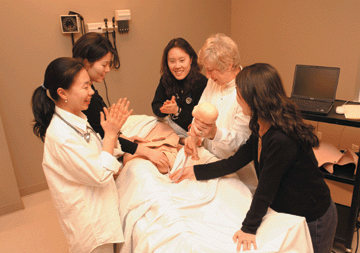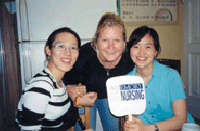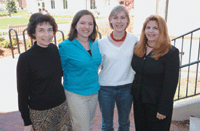Emory
Nursing students prove that the path to leadership begins early on

Taking Root
By Pam Auchmutey

Rachel
Shaw (center) shares an Emory nursing souvenir with nursing seniors Min
Kyung Song (left) and In Young Cho at Yonsei University.

Kathy Markowski (L–R) serves as the faculty adviser to the Emory Student Nursing Association. Members include Kristin Eberl, president; Anna Hess, legislative director, and Laura Yoho, president of the Georgia Association of Nursing Students.

Opportunity
knocks in interesting ways. For nursing senior Rachel Shaw, the path that
brought her to Emory was a combination of being in the right place at
the right time and the wrong place at the right time. Ultimately, both
have enabled her to test her wings as a nursing leader.
The first instance happened when Shaw spent a semester studying in Kenya
as an undergraduate student at Earlham College in Indiana.
“That experience changed my life,” says Shaw, who volunteered
in a Kenyan hospital. “I had no idea that malaria was so devastating.
The statistics never hit home until you live them. Working in a community
in western Kenya was such an eye-opener. I knew that public health was
the path that I wanted to go down.”
After graduating from Earlham, Shaw moved to Washington, DC, to work for
a nonprofit organization. She also studied public health at a DC location
run by Johns Hopkins. It was there that Shaw had her second awakening.
“I was in class one day when I realized that I didn’t have any
sense of what the instructor was talking about as far as disease processes
were concerned,” she recalls. “How can you write public health
policy and change the lives of people and the nature of their health care
without having a real sense of what they’re experiencing?”
That realization eventually brought Shaw to the School of Nursing, which
has nurtured her interest in community health and the world at large.
Shaw is the outgoing president of the Emory International Student Nursing
Association (EISNA) and was one of the first two Emory students to participate
in an academic exchange with the Yonsei University College of Nursing
in South Korea.
To date, two groups of students from Yonsei have studied at Emory. Organized
through the Lillian Carter Center for International Nursing, the exchange
strengthens a longtime link with Yonsei. The late Dr. San Cho Chun, 66MN,
led Yonsei’s nursing school as dean for many years. Emory nursing
Dean Marla Salmon traveled to Yonsei last fall to deliver a lecture in
Dr. Chun’s honor. Nurses from around the region attended.
A few months earlier, Shaw and Amy Brown, 02N, spent several weeks at
Yonsei. They met with faculty and students and visited hospitals, clinics,
schools, and other facilities to learn how South Korea’s health system
works. “Immediately, it became clear to us that South Korea takes
a much more preventive and promotional stance than the United States when
it comes to health care,” says Shaw. “So much of their health
care encompasses things like acupuncture, acupressure, and herbal remedies.
It’s phenomenal what we learned.”
Shaw and Brown also spent time with a nurse practitioner who works and
lives at a rural health clinic. “It was interesting to see traditional
medicine and the holistic approach in play in this particular rural community,”
says Shaw. “For all intents and purposes, the nurse practitioner
is the town doctor. The government takes a number of steps to educate
people to use nurse practitioners and clinics as resources.”
The experience taught Shaw some things about her own capabilities as well.
“It definitely has helped prepare me for leadership later on,”
she says. “By observing South Korea’s health care system, I
learned so much more about our own and some of the essential changes we
could make to better the lives of people.”
Back at Emory, Shaw began to think about providing international opportunities
for other students. Because resources for international travel are limited,
Shaw has focused on opening the doors to international nursing at home.
For example, EISNA works with the International Rescue Committee (IRC),
which places refugees and educates them about life in the United States.
EISNA recently conducted a clothing/item drive to provide items for the
IRC’s store, which provides revenue for the organization. During
their community health rotations, Emory nursing students have accompanied
IRC counselors on home visits to discuss health concerns with refugee
families.
Some day, Shaw hopes to pursue such interests on a global scale. “Before
I hit that level, I want to become very capable as a clinician,”
says Shaw. “Eventually, I would love to work with the United Nations
or the World Health Organization. The fact that the School of Nursing
has a focus in international health and offers the master’s and PhD
programs is dynamic. My experiences have prompted me to think about health
management and policy development as a career.”
An
advocate for change
Last semester, as DeKalb County Commissioner Gale Walldorff addressed
graduate nursing students in a health policy and financial resources class,
she shared her perspective on what it takes to change the world. “Nothing
happens unless you have an advocate to take your issue forward,”
she told the students.
Members of the Emory Student Nursing Association (ESNA) know what she
means. In addition to service projects, fund-raising, and increasing awareness
about their school and profession, the students advocate change in nursing
education and practice through legislative action. In October 2002, the
Georgia Association of Nursing Students (GANS) adopted an ESNA resolution
to improve the safety of hospitalized older adults through reducing the
use of physical restraints. Authored by Emory nursing senior Anna Hess,
the resolution was passed this spring at the National Student Nurses’
Association convention in Phoenix. Hess and other ESNA members were there,
accompanied by faculty adviser Kathy Markowski.
Hess confesses that she had only a vague notion about the issues facing
geriatric patients when she arrived at nursing school. That quickly changed
after she listened to her professors, including Dr. Elizabeth Capezuti,
a nationally known expert in improving the safety of hospital restraint
use among elderly patients.
“It was one of those needs in a population that you wouldn’t
consider until someone opened your eyes,” says Hess, who serves as
legislative director of ESNA.
She also learned a great deal from ESNA’s previous legislative director,
Stacy Armstrong, 02N. At the 2001 GANS convention, Armstrong proposed
a foreign language prerequisite for baccalaureate nursing students. The
ESNA proposal was defeated.
“You learn a lot from the setbacks,” says Hess, who attended
that convention. “There are lessons to be learned in the way legislation
is presented at the state convention. You know to make your argument that
much stronger next time.”
After she graduates this spring, Hess will begin an emergency and critical
care internship at St. Joseph’s Hospital in Atlanta. With time, she
hopes to become a geriatric nurse practitioner. No matter what path she
takes, Hess knows she has the power to shape her profession.
“The changes you hope to see in clinical practice can only come about
if you become involved. That first step has to be taken.”